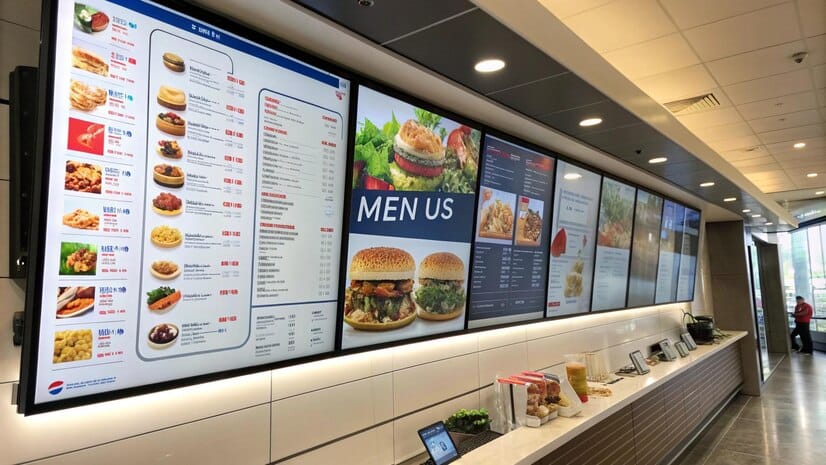A digital menu board is a set of related digital displays intended to convey information, entertainment, and advertising, as well as merchandise. These are also centrally controlled such that modifications aimed at reflecting audiences’ preferences or time frame can easily be done.
However, digital signage is not only the screens. It includes mounting systems, media players, software, services, cables, and other accessories, which play a crucial role in enhancing the system and keeping it up and running at optimum capability.
Where can a digital menu board be implemented in my organization?
In any place where conventional signs are used, a digital menu board proves useful. The properties of dynamism, flexibility, and attraction of digital displays make it possible for many settings and applications in organisations. Here are several examples of how digital displays can engage audiences and enhance their experience:
- Self-checkouts
- Virtual receptionist
- General information sharing
- Window displays
- Menu boards
- Digital billboards
- Wayfinding
- Emergency messaging
- Control rooms
- Outdoor displays and kiosks
What options are available for digital signage displays?
Today’s technology offers a plethora of digital menu board types, each presenting its own exciting possibilities:
Large-format displays (LFDs): boards that are mounted on the walls and which are outfitted with a flat screen with the capacity to display messages and presentations.
Video walls: A cluster of screens that has the possibility to change the information displayed on it.
Interactive flat panels (IFPs): The devices were touch panels that are intended for use as interactive whiteboards, video conferencing, and other means of sharing screens.
Kiosk is defined as compact screens or screen clusters used for information signage or advertisement.
Specialty displays: unique screen assemblies that are intended for particular location, circumstances, or audience requirements.
Outdoor displays: non-projection signs for viewing in the open public areas.
When selecting the right digital menu board display, certain factors must be taken into consideration, such as image quality, energy use, durability, and the right application.
How can I determine the most suitable digital menu board display for my use case?
Navigating the array of digital menu board display options can be challenging. Here’s a detailed breakdown of the five major digital display types:
- LCD (Liquid Crystal Display)
- LED (Light-Emitting Diode)
- QLED (Quantum Dot LED)
- dvLED (Direct View LED)
- OLED (Organic LED)
The fact that there are two types of display shows that each has its own strengths and weaknesses. So, at the time of choosing the source, it is important to consider elements like price, quality of image, energy consumption, and applicability of the source with the use.
Why is it necessary to use commercial-grade mounts for digital menu boards?
While consumer TVs are not fit for commercial use as signs, consumer-grade mounting equipment is subpar for commercial use. Here’s why opting for commercial-grade mounts is essential:
Durability: Public or heavy-duty mounts are designed to endure the harsh working environment that they are exposed to in commercial environments, hence more durable.
Security: Both commercial mounts come with strong structures to protect them from being tampered with or stolen to keep the mounted displays safe.
Safety: The commercial mounts do not compromise on safety, and thus the safety of the users is well guaranteed.
Installation & maintenance: The commercial mounts are made to be easy to install and easy to service, meaning that they do not have to be taken down for extended periods of time, which would increase the cost of the project.
What should one anticipate to get from a complete digital menu board package?
Purchasing a digital menu board solution involves more than just buying display screens. Now digital signage content management can be defined as a combination of a physical display, content, and support services.
Here’s what a complete digital signage solution entails:
Hardware: Digital Signage Display, Digital Signage Mounting Solutions, Digital Signage Media Players.
Services: consultation, sales, integration, configurative and installation services, implementation services, and maintenance services.
Content management: communication software for content delivery helps to develop, customize, and disseminate messages.
Working with a reliable vendor allows one to have the necessary skills and tools to develop proper digital menu board solutions for the company.





